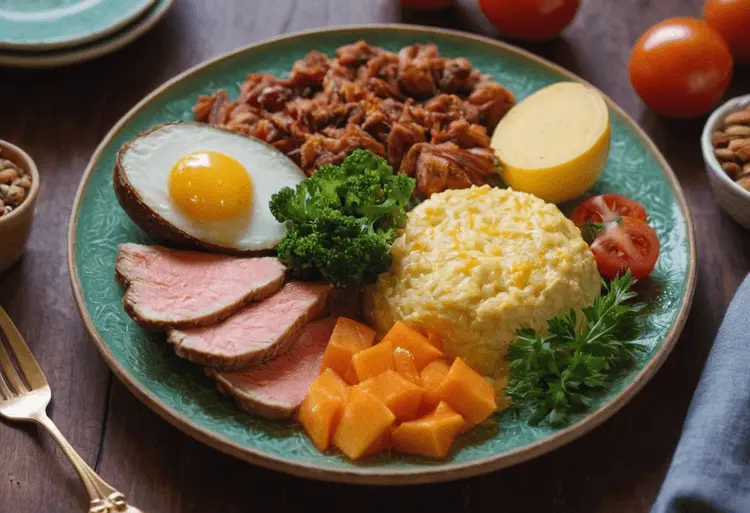Ketogenic Diet: Tired of fad diets that leave you feeling hungry and unsatisfied? The ketogenic diet, a low-carb, high-fat eating plan, offers a refreshing alternative.
By shifting your body into ketosis, where it burns fat for fuel instead of carbs, the keto diet has gained popularity for its potential to promote weight loss, improve blood sugar control, and boost mental clarity.
But what exactly does it entail? How do you get started with a ketogenic meal plan? And what’s this “keto flu” everyone talks about?
This beginner’s guide will walk you through the ins and outs of the ketogenic lifestyle, covering the basics of ketosis, food choices, potential benefits, and common challenges.
Whether you’re a keto newbie or looking to refresh your knowledge, this guide is your roadmap to unlocking the fat-burning power of keto.
Keto Diet at a Glance
- Low-carb, high-fat diet
- Burns fat for fuel
- Potential weight loss
- May improve blood sugar
- Talk to your doctor first
Table of contents
Introduction to the Ketogenic Diet

Have You Ever Wondered How to Tap into Your Body’s Fat-Burning Superpower?
The ketogenic diet, often called “keto,” might just be the answer you’ve been searching for. But what is this diet everyone’s buzzing about?
What is the Ketogenic Diet?
In a nutshell, the ketogenic diet is a low-carb, high-fat eating plan that tricks your body into switching its primary fuel source from glucose (sugar) to ketones (fat).
So, what are ketones? They are molecules produced by your liver when you drastically reduce your carbohydrate intake. These little powerhouses become your body’s new favorite energy source, leading to some pretty amazing benefits.
For a deeper dive into the science behind ketones and how the ketogenic diet works, check out this comprehensive review from the Harvard T.H. Chan School of Public Health: Diet Review: Ketogenic Diet for Weight Loss
Why Is Everyone Going Keto?
The ketogenic diet has taken the world by storm, and for good reason. While it might seem like the latest fad, its roots run deep, dating back to the 1920s as a treatment for epilepsy.
However, its true claim to fame today is its remarkable weight loss potential. By forcing your body to burn fat for fuel, the ketogenic diet can help you shed those extra pounds and feel more energized than ever.
How Does Keto Stack Up Nutritionally?
The ketogenic diet typically consists of:
- High Fat: 70-80% of your daily calories
- Moderate Protein: 15-20% of your daily calories
- Very Low Carb: 5-10% of your daily calories
Interested in learning more about how the ketogenic diet has been used to manage epilepsy? The Charlie Foundation provides valuable information and resources: The Charlie Foundation
Are you ready to embark on your keto journey? Share your thoughts and experiences in the comments below or tag us on social media! We’d love to hear from you.
Ready to kick your keto journey into high gear? If you’ve mastered the basics and crave a deeper dive into a no-carb lifestyle, “Unchain Yourself: Dive Into the World of No-Carb Diet Plan” is your next adventure. It’s time to unleash your full fat-burning potential!
Benefits and Risks of the Ketogenic Diet – A Double-Edged Sword?
The ketogenic diet isn’t just about bacon and butter (although those are delicious perks). It’s a powerful metabolic tool with the potential to transform your health – but like any tool, it needs to be used wisely.
Let’s dive into the good, the bad, and the “keto flu”-y.
The Keto Upside: Potential Benefits
Weight Loss: Ever felt like you’re constantly fighting hunger pangs? The ketogenic diet may be your secret weapon. By shifting your body into fat-burning mode, keto can suppress appetite and help you shed those stubborn pounds.
Studies have shown impressive results, with some people experiencing significant weight loss on keto.
Blood Sugar Control: If you’re living with type 2 diabetes or struggling with blood sugar swings, the ketogenic diet might be a game-changer.
By reducing carb intake, keto can help improve insulin sensitivity and keep your blood sugar levels in check. It’s like giving your body a much-needed tune-up!
Harvard T.H. Chan School of Public Health’s review of the keto diet suggests that this eating pattern may indeed be effective for weight loss and blood sugar control.
Other Potential Perks: Beyond weight loss and blood sugar control, the ketogenic diet may offer a range of other benefits. Some people report increased mental clarity, reduced inflammation, and even improvements in conditions like epilepsy.
However, more research is needed to fully understand these effects. A meta-analysis on the effects of ketogenic diets on metabolic parameters provides a comprehensive overview of the current research landscape.
The Keto Downside: Potential Risks and Side Effects
Keto Flu: Starting a ketogenic diet can feel like you’ve come down with a weird bug. You might experience fatigue, headache, nausea, and other flu-like symptoms. This is the infamous “keto flu.”
But don’t worry, it usually passes within a few days as your body adjusts to using ketones for fuel.
Nutrient Deficiencies: While keto is all about healthy fats, it can be easy to miss out on essential nutrients if you’re not careful. Supplementing with vitamins and minerals like potassium, magnesium, and vitamin D can help fill the gaps and keep you feeling your best.
Other Risks: Constipation, kidney stones, and even adverse interactions with certain medications are also potential risks of the ketogenic diet. It’s crucial to talk to your doctor before starting keto, especially if you have any underlying health conditions.
Embarking on Your Ketogenic Diet Journey

Ready to dive into the world of ketosis? It’s exciting, but taking the first step can feel a little daunting. Don’t worry, we’ve got your back. Here’s your step-by-step guide to starting the ketogenic diet, tailored to your needs and goals.
1. Finding Your Keto Balance: Macronutrients Made Easy
The ketogenic diet isn’t just about cutting carbs. It’s about finding the perfect balance of macronutrients – the building blocks of your food. So, what does that look like? Typically, you’ll aim for:
- Fat: 70% of your daily calories (Your body’s new BFF for energy!)
- Protein: 20% of your daily calories (Essential for muscle maintenance and repair)
- Carbohydrates: 10% of your daily calories (Kept low to trigger ketosis)
But everyone’s different! Your ideal macros will vary depending on your age, activity level, and goals. Thankfully, there are plenty of handy online calculators that can help you figure out your personal macro magic.
Pro Tip: Remember, net carbs are what count on keto. To calculate net carbs, subtract fiber from total carbs.
2. Keto-fy Your Kitchen: Out with the Old, In with the Delicious
Now for the fun part: stocking your kitchen with keto-approved goodness. Think vibrant vegetables, juicy meats, creamy cheeses, and a whole lot of healthy fats. To set yourself up for success, prioritize these foods:
- Meats and poultry: Grass-fed beef, chicken, turkey, pork, and wild-caught fish.
- Eggs: Pastured or omega-3 enriched are best.
- Low-carb vegetables: Leafy greens, broccoli, cauliflower, zucchini, asparagus, and more.
- Healthy fats: Avocado, olive oil, coconut oil, nuts, seeds, and fatty fish.
- Dairy: Full-fat cheese, butter, and unsweetened yogurt.
At the same time, it’s time to say goodbye to the carb-laden culprits:
- Grains: Bread, pasta, rice, and cereals.
- Sugar: Candy, desserts, soda, and sweetened beverages.
- Starchy vegetables: Potatoes, corn, and peas.
- Most fruits: Save berries for occasional treats.
- Processed foods: Anything with added sugar, unhealthy fats, or artificial ingredients.
3. Meal Planning and Recipes: Flavorful Fuel for Your Journey
With your kitchen stocked with keto-friendly ingredients, it’s time to get creative in the kitchen! There are endless delicious possibilities to explore.
- Breakfast: Eggs and bacon, avocado smoothies, or chia seed pudding.
- Lunch: Salads with protein, soups, or leftovers from dinner.
- Dinner: Grilled meats or fish with vegetables, stir-fries, or casseroles.
- Snacks: Nuts, seeds, cheese, hard-boiled eggs, or keto-friendly fat bombs.
- Desserts: Berries with whipped cream, dark chocolate, or keto-friendly baked goods.
Remember, this is your journey. Experiment with different recipes and find what works best for your taste buds and lifestyle. Need some inspiration? The internet is overflowing with delicious keto recipes just waiting to be discovered.
Bonus Tip: Don’t forget to track your macros! This will help you stay on track and ensure you’re hitting your nutritional goals. There are plenty of apps available to make this process a breeze.
Embarking on Your Ketogenic Journey: Is It Right For You?

The ketogenic diet is more than just a weight loss trend; it’s a metabolic shift with potential benefits ranging from improved blood sugar control to enhanced mental clarity. But is it the right fit for you?
Delve Deeper: Understand the Nuances
To truly understand the impact of a ketogenic diet on your health, dive into reputable resources like the Harvard T.H. Chan School of Public Health’s review or explore the Charlie Foundation’s insights on its use for epilepsy.
These in-depth analyses provide a well-rounded perspective.
Your Health, Your Choice
Remember, the best way to determine if the ketogenic diet aligns with your goals is through research and personalized guidance. Consult with a healthcare professional or registered dietitian to discuss if this low-carb, high-fat lifestyle is suitable for your individual needs and health conditions.
The Nutrient-Rich Path to Ketosis
A well-formulated ketogenic diet is packed with nutrient-dense foods like leafy greens, avocados, fatty fish, and nuts. These provide essential vitamins, minerals, and antioxidants to support your overall well-being.
Join the Conversation
Have you tried the ketogenic diet? We want to hear your experiences! Share your thoughts, questions, or keto recipes in the comments below. Let’s create a supportive community where we can learn and thrive together. Feel free to tag us on social media using #MyKetoJourney and connect with fellow keto enthusiasts.
Looking for a diabetes-friendly way to manage your blood sugar? The ketogenic diet may not be the best fit. Head over to our guide on “Diabetic Diet Tips: Eat Well, Manage Blood Sugar” for a personalized approach that puts your health first
Your Burning Keto Questions, Answered!
Navigating the ketogenic diet can be exciting, but it comes with its fair share of questions. Let’s tackle some of the most common ones head-on:
Healthy fats (avocado, olive oil), meats, fish, eggs, low-carb vegetables, nuts, and seeds.
It can be, but it’s important to consult your doctor and ensure you’re getting all the nutrients you need.
A high-fat, low-carb diet that shifts your body into using ketones (from fat) for energy instead of glucose (from carbs).
Drastically reduce carbs, consume moderate protein, and prioritize healthy fats.
Research is ongoing. Consult your doctor before starting, especially if you have health conditions.
Absolutely! Focus on avocados, nuts, seeds, and low-carb veggies. Check out The Charlie Foundation for resources.
Hard-boiled eggs, celery with almond butter, cheese, olives, and berries are great options.
Stay hydrated, increase electrolytes (broth, leafy greens), and ease into the diet gradually.